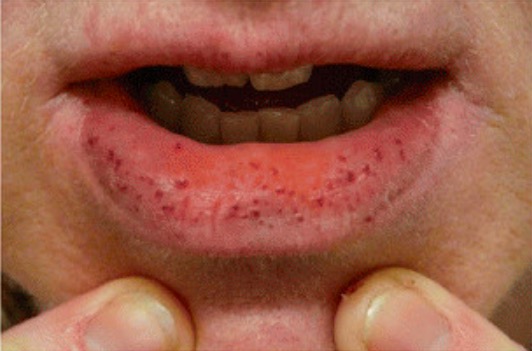Playlist
Show Playlist
Hide Playlist
Hypercoagulability: Secondary Causes
-
Slides Clotting Disorders.pdf
-
Download Lecture Overview
00:01 So children can also have secondary causes of hypercoagulability. 00:07 This includes disease entities like any sort of cancer in teens who smoke, patients who are on oral contraceptives can absolutely get clots; immobility, for example, on an airplane flight. 00:22 Patients with lupus might have antiphospholipid antibodies or patients with no lupus might also have that condition and those patients are at increased risk for clots. 00:34 Especially, neonates may have indwelling lines that can form a clot around the spot of that line and that’s something we have to keep an eye out for. 00:42 Patients with liver or kidney disease may occasionally develop a secondary hypercoagulability and certainly patients with vasculitis do because of the endothelial wall damage. 00:53 Of course, patients with sickle cell can and do form clots during their childhood period. 01:00 What we should think about in patients is that the more risk factors they have for a hypercoagulable state, the more likely they are to form clots. 01:10 So a teenager who is on oral contraceptives and that’s their only risk factor, it’s very unlikely they will actually form a clot. 01:18 Additionaly COVID-19 infection, or the multisystem inflammatory syndrome in children, or MIS-C, which occurs typically 4 weeks after the COVID-19 infection in children, can cause clots in children. 01:31 However, if they are obese, frequently immobile and they smoke, now we might have a big problem. 01:38 So what’s key is that children who form the clot are most likely to have multiple causes or multiple different causes within that Virchow’s triad and that’s we have to think about in terms of a child who is having a stroke or an MI or other problems along those lines. 01:56 How do we treat the hypercoagulable state? Certainly, children may be placed on low molecular weight heparin subQ. 02:04 Unfortunately, this is a shot every day and obviously, children especially the little one who don’t understand why, don’t like this very much. 02:12 These are daily injections. 02:14 The other thing is different than adults. 02:16 It’s in children we do have to check an anti-factor 10A level to verify our dosing. 02:22 So in adults, that’s not necessary, but in children after the third dose, we’ll get an anti-factor 10A level to verify that the dose is correct and we will adjust it based on that level. 02:35 In the acute setting, we can certainly use heparin. 02:37 Of course, that’s IV only and we titrate it to the correct PTT desire. 02:44 It’s every 6 hours, so this is really limited in hospitalized patients. 02:49 If we have a patient who we want to place on oral agents for preventing hypercoagulability which is quite rare in children, we will probably use warfarin. 02:59 It’s an anticoagulant that inhibits vitamin K and so it’s quickly reversible in the event that we’ve overdosed in a patient who is having bleeding problems. 03:08 The initiation of warfarin, remember, is associated with an inhibition of protein C and S, which are also vitamin K dependent. 03:17 As a result, we will often start warfarin in concert with heparin or low molecular weight heparin and then once we have been on for a while, we will then turn off the heparin and continue the warfarin. 03:31 There are newer agents out there that are oral anticoagulants that you’ve heard about in adult medicine. 03:37 Drugs like dagibatran or rivaroxaban or apixaban. 03:44 All of these are oral agents that have some advantages over the warfarin which also an oral agent. 03:51 In particular, they are less likely to cause sentinel bleed events and we don’t have to follow the levels very carefully like we do with warfarin or we’re constantly following that INR. 04:04 Alternatively, for patients who have an acute clot, we may decide to try to break open these clots. 04:14 This is called thrombolytic therapy. 04:16 Examples are TPA or urokinase. 04:21 We do use these drugs commonly in complicated pneumonia but not really for clots. 04:27 So for example, in a complicated pneumonia where we have placed a chest tube and we want to break open those fibrinous areas within the complex pulmonary pleural effusion, we will inject the TPA or urokinase into the chest tube as a way of breaking up those fibrinous bands. 04:45 But these drugs are rarely used in children, it’s not that we don’t care about a child who has just had a stroke, the problem is that strokes in children can present so nonspecifically and they are so incredibly rare that it's unlikely that we’ll have figured out that the child is having a stroke prior to the time it will take to actually have an affected period when the thrombolytic therapy can be used. 05:10 Again with thrombolytic therapy, we worry about significant risk of bleed. 05:15 So it’s unlikely you will see this drug used in children for an acute clot breakup. 05:21 So that’s my summary of the hypercoagulability in children. 05:25 Thanks for your attention.
About the Lecture
The lecture Hypercoagulability: Secondary Causes by Brian Alverson, MD is from the course Pediatric Hematology. It contains the following chapters:
- Secondary Causes of Hypercoagulability
- Hypercoagulability – Management
Included Quiz Questions
Which of the following is an appropriate outpatient treatment for hypercoagulability?
- Low-molecular-weight heparin
- Conventional heparin
- Recombinant Factor VII
- Recombinant Factor VIII
- Desmopressin
Which of the following is not a secondary cause of hypercoagulability?
- Factor V Leiden
- Oral contraceptives with estrogen
- Vasculitis
- Antiphospholipid antibodies
- Malignancy
Which of the following is the most likely secondary cause of venous thromboembolism in an active obese teenage girl who is on oral contraceptives and who does not have a previous history of a serious illness?
- A combination of obesity, smoking, and oral contraceptives
- Obesity
- Smoking
- Excessive physical activity
- Protein C deficiency
A 10-year-old boy is on long-term therapeutic doses of low-molecular-weight heparin subsequent to a venous thromboembolic event. Which of the following is the most appropriate test for monitoring therapy in this patient?
- Anti-factor Xa levels
- Low-molecular-weight heparin levels
- PT/INR
- PTT
- Monitoring is not required in this patient.
Which of the following unwanted effects is associated with initiation of warfarin therapy?
- Inhibition of protein C and S
- Activation of prothrombin
- Inhibition of platelet aggregation
- Activation of anti-factor Xa
- Delay in platelet aggregation
Customer reviews
5,0 of 5 stars
| 5 Stars |
|
5 |
| 4 Stars |
|
0 |
| 3 Stars |
|
0 |
| 2 Stars |
|
0 |
| 1 Star |
|
0 |




